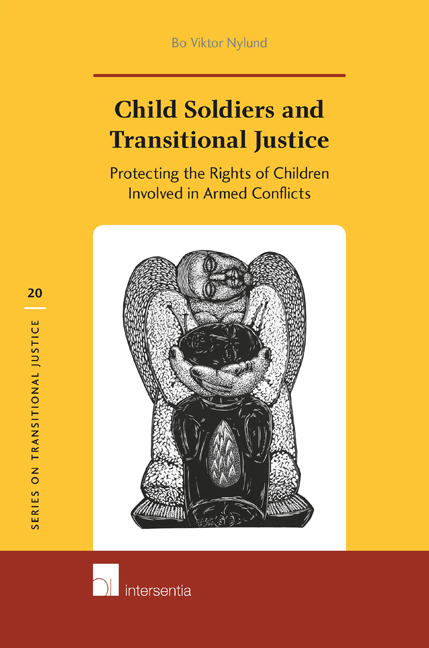 Child Soldiers and Transitional Justice
Child Soldiers and Transitional Justice Book contents
- Frontmatter
- Acknowledgements
- About the Author
- Contents
- List of Abbreviations
- Chapter 1 Objective, Scope, and Transitional Justice as an Analytical Framework
- Chapter 2 Child Recruitment and the Rule of Law: International Law and the Prohibition against Recruiting and Using Children to Take Direct Part in Hostilities
- Chapter 3 Child Recruitment and Criminal Justice: the Lubanga Case
- Chapter 4 Child Recruitment and Historical Justice: the Security Council Mechanism on Monitoring and Reporting
- Chapter 5 Child Recruitment and Reparatory Justice: Recovery and Reintegration of War-Affected Children
- Chapter 6 Child Recruitment and Institutional Justice
- Chapter 7 Children Involved in Armed Conflict and Participatory Justice: Balancing Rights and Responsibilities
- Chapter 8 Conclusions: Transitional Justice and the Potential for Stronger Protection of the Rights of Children Involved in Armed Conflicts
- Annexes
- Bibliography
Chapter 8 - Conclusions: Transitional Justice and the Potential for Stronger Protection of the Rights of Children Involved in Armed Conflicts
Published online by Cambridge University Press: 12 December 2017
- Frontmatter
- Acknowledgements
- About the Author
- Contents
- List of Abbreviations
- Chapter 1 Objective, Scope, and Transitional Justice as an Analytical Framework
- Chapter 2 Child Recruitment and the Rule of Law: International Law and the Prohibition against Recruiting and Using Children to Take Direct Part in Hostilities
- Chapter 3 Child Recruitment and Criminal Justice: the Lubanga Case
- Chapter 4 Child Recruitment and Historical Justice: the Security Council Mechanism on Monitoring and Reporting
- Chapter 5 Child Recruitment and Reparatory Justice: Recovery and Reintegration of War-Affected Children
- Chapter 6 Child Recruitment and Institutional Justice
- Chapter 7 Children Involved in Armed Conflict and Participatory Justice: Balancing Rights and Responsibilities
- Chapter 8 Conclusions: Transitional Justice and the Potential for Stronger Protection of the Rights of Children Involved in Armed Conflicts
- Annexes
- Bibliography
Summary
“I hope my family wants me back.”
INTRODUCTION
The number of child soldiers appears to have decreased slightly during the past several years, due to solutions in some long-term conflicts and significant releases of children. This is no doubt partly the result of the consistent advocacy and action taken by actors in the different spheres of transitional justice. Recently escalating conflicts, however, have generated significant reports of new recruitments of children under varying degrees of coercion to be used by armed forces and groups to wage war. There is still significant work to be done: the 2014 report includes the listing of eight government forces and 51 armed groups.
Approaching the issue of child recruitment from the perspective of transitional justice provides a fresh perspective on ways to prevent and redress this grave violation of children's rights. This approach aims to systematize the law, knowledge, and practice across a wide range of legal fields. It allows for a synthesis of legal debate, a greater understanding of the established law and principles, and a more informed basis for practical engagement with transitional justice mechanisms.
This concluding chapter focuses on two main streams: (1) it undertakes a final legal analysis of the law related to child recruitment, and (2) it makes suggestions about the way forward and how the different aspects of transitional justice can more successfully come together.
ANALYSING INTERNATIONAL LAW RELEVANT TO CHILD RECRUITMENT THROUGH THE TRANSITIONAL JUSTICE FRAMEWORK
This section brings together the lessons from having used the transitional justice framework as the point of departure. It begins with an exploration of the outcomes of having used the framework and then considers the conclusions that can be made on the state of the art with respect to international law related to child recruitment.
ADVANTAGES OF AN OVERALL FRAMEWORK
The key advantage of looking at children's issues through the lens of transitional justice rather than a single area of law is that it is possible to consider the entire “life cycle” of the event of child recruitment, from root causes and prevention to the nature of the violation itself, along with the options and solutions to address the violation.
- Type
- Chapter
- Information
- Child Soldiers and Transitional JusticeProtecting the Rights of Children Involved in Armed Conflicts, pp. 213 - 230Publisher: IntersentiaPrint publication year: 2016
- 1
- Cited by
